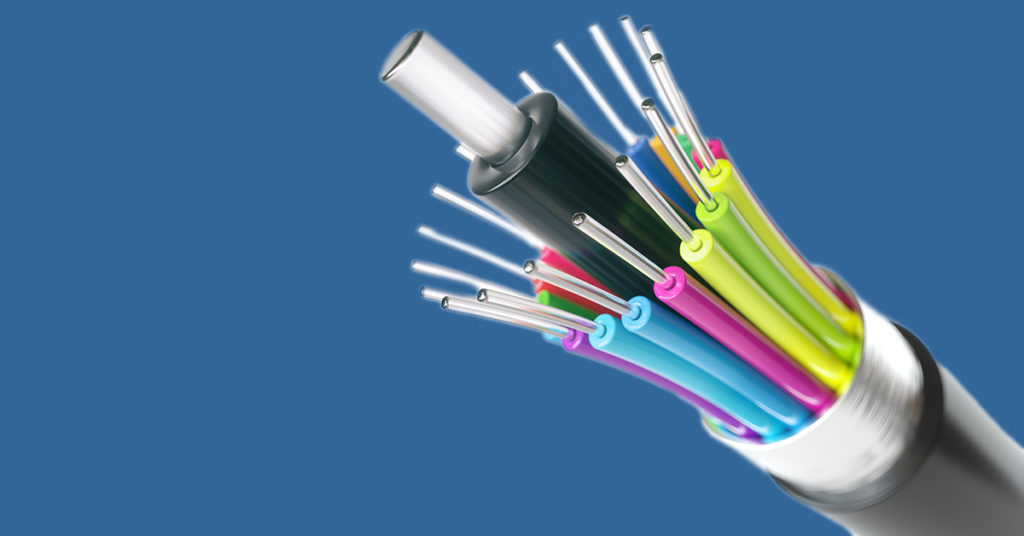
What Is Fiber-Optic Internet?
3 commentsInternet and technology companies have a well-earned reputation for throwing around fancy buzzwords that, when it comes down to it, mean very little for real people. Occasionally, though, something that sounds like it might just be the latest idea from the marketing department really delivers. This is the case with fiber-optic internet. It’s high-speed broadband service straight from the minds of the engineers and scientists.
Internet inside
Fiber, or fiber-optic, internet is the fastest broadband service widely available. Data is transmitted as beams of light sent (by lasers!) through fiber-optic cables. It’s a much better system for transferring information quickly than the old copper telephone wires that are used in the DSL internet connection most people currently have.
Fiber internet is so much faster than DSL because of what’s inside the cables. Fiber-optic cable, also called optical fiber, is made up of three parts: a thin inner “core,” surrounded by a slightly thicker “cladding,” both shielded by a “buffer” layer that protects the fiber layers from being degraded or destroyed by weather.
The core, which is just thicker than a strand of human hair, and the cladding of a fiber-optic cable are normally made from different types of ultra-pure glass. The two work together to transmit light at, well, the speed of light, using a technique called “total internal reflection.” You might have covered it in high school science class, but here’s a refresher.
The glass the core is made from has a higher “refractive index” than the glass the cladding is made from. This means that light travels more slowly through the core than it does through the cladding. You know how when you put your arm into a swimming pool and it looks like it’s bending? That’s because water has a higher refractive index than air. It’s the same scientific principle at play inside fiber-optic cable but, instead of bending and passing through the cladding like the light does in the swimming pool, the light beam is sent through the core at a shallow enough angle that it gets bounced back. This way, a single beam of light gets trapped inside the core, careening along, from cladding sidewall to cladding sidewall, carrying all that important data.
It’s because of how well light is contained inside the core that fiber is so much better than traditional copper cables. With copper, the data signals are sent as electrical currents, which are far more susceptible to interference. Other nearby cables, strong radio frequencies, temperature, distance from the source and lots of other factors can all increase the attenuation—how much strength a signal loses—in a copper wire. The longer the copper cable that data has to pass through, the slower and lower quality the internet connection at the other end will be. Fiber still suffers from attenuation, but at a much slower rate than copper cables. Light just can’t be interfered with by its surroundings in the same way.
While optical fiber might sound like it would be fragile, it’s anything but. The ultra-pure glass used in its construction is pretty flexible and the buffer does a good job of keeping away moisture, dirt and anything else that could damage the core and cladding. Multiple fiber-optic wires are bundled together into bigger fiber cables that are wrapped in even thicker protective layers and buried underground to keep them safe from floods, hurricanes and other disasters.
Plus, nobody is going to dig up your fiber-optic cable and sell it for scrap.
Internet at the speed of light
Modern fiber-optic cables have been around for 50 years, but it’s taken a while for the technology to trickle out to regular customers’ homes.
If you have a DSL internet connection, your Instagram Stories and favorite Netflix shows are still traveling along the fiber-optic internet—just not for the last mile or two. The high-speed “backbone” that connects your internet service provider to the internet at large is built of fiber-optic cables. And fiber-optic cables are even sending signals undersea across the Atlantic. It’s only the last link in your connection, the section between your house and the nearest exchange, that’s copper. And that’s where all the slowdown happens.
If you’re fortunate enough to live where you can get a fiber to the home (FTTH) connection, your internet speeds are sorted for the next few decades. You’ve got fiber from your computer to the rest of the internet, delivering nearly identical upload and download speeds.
The fiber future
As science fiction writer William Gibson said, “The future is already here—it’s just not very evenly distributed.” Well, fiber is here now and, over the next few years, it’s going to get much more evenly distributed. This is good news for everyone who wants a fast, stable, weather-safe internet connection.


This is really good.
Is there such thing as wireless fiberoptic transmission ?
Hi Julius, good question! Fiber optic is not wireless, however data can be sent wirelessly through the air over light or lasers. Instead of the medium being a closed and highly efficient environment like a fiber optic cable, it is the air. I suppose it could also be the vacuum of space as well, but in all cases there is the possibility of particles or obstructions. Fiber cable allows the optical signal to be curved or bent around obstacles and is perfectly clear, whereas an optical signal outside of fiber would need to be line of site. Due to these limitations, Wi-Fi over radio waves is a better choice since line of sight, while ideal, isn’t absolutely required. For that reason it’s probably best we keep optical wireless data transmission limited to our TV remotes!